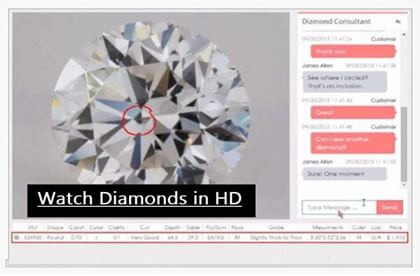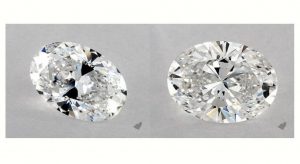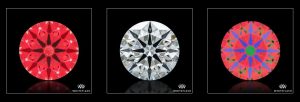An unrefined diamond has its scintillation, fire, and brilliance that make the diamond beautiful, locked within it. The way and the grade to which the diamond cutter cuts the diamond determines how these three will combine to make a beautiful and brilliant diamond.
The pavilion of a diamond is the lower part of the diamond that takes the shape of a cone. The angle which the pavilion facet of a diamond makes with the girdle plane of the diamond is what is called the pavilion angle. The pavilion angle of a diamond is an important diamond proportion because it largely determines the level of brilliance and fire that a diamond would have.
A diamond’s pavilion acts as a mirror for the diamond and the pavilion’s mirroring ability is determined by the refractive index of the diamond. The refractive index of the diamond determines the angle at which the light that comes into the diamond is bent. The diamond’s pavilion is only able to play the role of a mirror when its critical angle is less than the angle at which the light is hitting it. Generally, the greater the diamond’s refractive index, the steeper you can cut the diamond before light begins to escape from it.
When the pavilion of a diamond is too deep, the light that enters the diamond perpendicular to the diamond’s table facet is usually not steep enough to escape through the diamond’s first pavilion facet. The reason is that the first pavilion facet of the diamond is unable to bend the light well enough for the light to not escape through the diamond. So the light escapes through the opposite pavilion.
If the pavilion of the diamond is too shallow, the pavilion tends to over bend the light that enters the diamond through the crown. This leads to the light being reflected off the opposite crown facet instead of it to bounce across the second pavilion. So the light escapes from the pavilion facet instead of being reflected back by the pavilion.
In an ideal case where the pavilion angle is not too deep or too shallow, the light that enters into the diamond through the crown is bent to the right proportion, so that the light is reflected back, through the diamonds table facet, to the eye of the observer. The light is bent such that it is not able to escape from the diamond through the opposite pavilion.
The pavilion facet and crown facet of a diamond can be combined in a way that there is a right balance between the fire produced by a diamond and the diamond’s brilliance, while at the same time ensuring that light is not allowed to escape from the diamond. This defines the relationship between the pavilion angle and the crown angle of a diamond.
Relationship between the Pavilion Angle of a Diamond and the Crown Angle of the Diamond
The crown angle of a diamond is the angle formed between the girdle and the table of the diamond. It determines the amount of dispersion in the diamond and consequently the amount of fire that the diamond exhibits.
There is a relationship between the crown angle and pavilion angle of a diamond. They actually work together and compensate each other in a diamond.
The bending of light in the pavilion is compensated for by the crown angle of the diamond. When a diamond’s pavilion angle is steep, the crown angle must be shallow to compensate for the pavilion angle and when the pavilion angle is too shallow, the crown angle has to be steep to compensate for it. The steeper one is, the shallower the other should be. This means that for every pavilion angle, there is a crown angle that maximizes its light return. This relationship between the crown angle and the pavilion angle of the diamond plays a hugely important role in the overall look of the diamond.
The amount of light that returns to the eye of the one viewing the diamond (the diamond’s brilliance) is determined by the pavilion angle. If the pavilion angle is too shallow, the diamond will be too shallow and if the pavilion angle is too steep, the diamond will be too deep. But these defects can be balanced out by the appropriate crown angles.
Diamond researchers have discovered that the ideal pavilion angle for diamonds is between the ranges of 40.6 degrees to 41.0 degrees. This is the range that gives the diamond the utmost brilliance.
According to Marcel Tolkowsky, the ideal pavilion angle of a diamond is 40.75 degrees and the ideal crown angle is 34.5 degrees. This means that if you have a diamond with a pavilion angle of 40.6 degrees (and bends light excessively), the ideal crown angle for to compensate for that pavilion angle is a steeper crown angle of 35 degrees. So also if the diamond has a 41 degrees pavilion angle (and doesn’t bend light well enough), the ideal crown angle to compensate for that pavilion angle is a shallower crown angle of 34 degrees.
Going by this analysis, the ideal pavilion angle for diamonds, to compensate for the different crown angles is 40.6 – 41 degrees. With this, we have two different ideal crown angles, the shallow ideal crown angle and the steeper ideal crown angle and these two are very different from each other.
If this detail is taken into consideration when cutting the diamond, the brilliance and light performance of the diamond will be brilliant.
Conclusion
The ideal pavilion angle for diamonds is 40.75. If that is to increase in a diamond, it will lead to leakage of light and it can cause the center of the diamond to become noticeably dark. If the diamond pavilion is very deep, the darkness might cover the table and extend further, forming what is known as the ‘nail head’. If the pavilion angle is also decreased by at least 2 degrees, it will result in what is called the ‘fisheye effect’, where the reflection of the diamond girdle is seen on the diamond table. There’s not enough to say about perfection when it comes to the pavilion angle of a diamond.
Executive summary
A diamond’s pavilion the lower part of the diamond that takes the shape of a cone. The angle which the pavilion facet of a diamond makes with the girdle plane of the diamond is what is called the pavilion angle. The pavilion angle is very important to a diamond because it plays an important role in determining the amount of brilliance and fire that a diamond will exhibit.
The pavilion angle of a diamond must not be too deep or too shallow. If it is too deep, the first pavilion facet of the diamond will be unable to bend the light well enough for the light to not escape through the diamond. So the light escapes through the opposite pavilion. If it is too shallow, the light that enters through the diamond crown is bent too much. This leads to the light being reflected off the opposite crown facet instead of it to bounce across the second pavilion. So the light escapes from the pavilion facet instead of being reflected back by the pavilion. But when it is cut to ideal proportions, the light that enters into the diamond through the crown is bent to the right proportion, so that the light is reflected back, through the diamonds table facet, to the eye of the observer. The light is bent such that it is not able to escape from the diamond through the opposite pavilion.
The pavilion angle and crown angle of a diamond work together to achieve a balance between the brilliance and fire of a diamond. If the pavilion angle is steep, the crown angle will be shallow and vice versa. This is how they complement themselves. The ideal pavilion and crown angles for diamonds are 40.75 and 34.5 respectively. For a steep pavilion angle of 41 degrees, the corresponding crown angle is 34 degrees. For a shallow pavilion angle of 40.6 degrees, the corresponding crown angle is 35 degrees.




